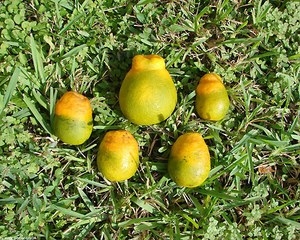
By Christopher Vincent, Anirban Guha, Joon Hyuk Suh and Yu Wang
It may surprise you to learn that citrus trees can get too much sunshine in the Sunshine State. Manipulating the light environment around a plant can have several surprising benefits. Shade can suppress the HLB cycle and enhance citrus health and yield. Overall, a mildly shaded citrus plant is likely to have fewer signs of stress, less HLB-spreading psyllids, less severe HLB symptoms and higher yield.
Our groups have joined with several others at the University of Florida to assess how shade impacts the various dynamics of pests, disease, plant health and horticulture. HLB is spread by Asian citrus psyllids landing on trees. Previous researchers observed that low light reduced psyllids landing on trees in a laboratory and that the shaded sides of trees in the field had fewer psyllids.
In our initial study at a natural forest site, we found it was difficult to find psyllids on feral citrus trees in shaded hammocks, and very few trees were infected with Candidatus Liberibacter asiatius (CLas), the bacterium that causes HLB. We think fewer psyllids land on shaded trees because psyllids use light reflecting off distant trees to locate them. If there is less reflection, the trees are less likely to be spotted. We also found very few symptomatic leaves in the forest site. Leaves showed few signs of stress to their photosynthetic machinery, regardless of whether the trees had HLB.
We followed our forest study by examining sweet orange in the field with 4-year-old Hamlin trees that were all infected and showed strong HLB symptoms. We installed shade netting with 30, 50 or 70% shade over the trees in late 2018 and followed their growth and health over two years.
IMPROVEMENTS
There is evidence that the trees' health has improved, though they are HLB infected. When we performed a whole leaf metabolomic analysis in spring and fall, we found many changes in the metabolic profile, including prominent changes in leaf hormonal balance and the metabolism of sugars and nitrogen. In association with the hormonal changes, the shaded trees have less intense flushes, though their canopies are not less dense. This indicates the leaves likely have longer lifespans in the shade, counteracting an important symptom of HLB: leaf drop.
The shaded leaves had less foliar starch, meaning shade mitigates the typical starch accumulation induced by HLB. Along with the reduction in starch, the shaded leaves also accumulated more of the sugars involved in carbohydrate export from the leaf, indicating that phloem may be functioning more effectively, though this point needs more research.
These results, combined with evidence that leaf water status has improved, suggest that CLas-infected trees in the shade are healthier than in full sun. Thus, it comes as no surprise that shade improved yields. Over the two years of the study, the trees under 30% shade produced twice the yields of those in full sun.
Of course, too much of a good thing is still too much. Increasing shade beyond 30% continued to mitigate stress in the leaves but did not improve yields. Based on work done by our predecessors at the Citrus Research and Education Center, increasing shade intensity too much leads to a reduction in the flowering needed to set a good crop. The shade needs to be sufficiently moderate to help avoid the worst of the sun- and heat-induced stress while still spurring the trees to make fruit.
SHADE OPTIONS
Despite these benefits, there are challenges to using shade in horticulture. Although shade netting is frequently used in some international citrus regions, such as South Africa and Australia, installing large shade structures may not be cost effective for many Florida growers.
A notable exception to this is the construction of many citrus under protective screen (CUPS) structures and individual protective covers that are installed on young trees. Although these are implemented as exclusion netting to prevent the arrival of psyllids on the trees, the nets also provide the environmental benefits of shade, including a warm humid environment that does not overload the leaves with too much light.
Particle films can also provide temporary, sprayable shade. These consist of particles that can be put in suspension and sprayed on leaves, leaving them to dry as a film.
Our ongoing experiments with kaolin particle films have demonstrated that these treatments also reduce disease pressure and leaf water deficit while enhancing tree growth and yield. We studied the application of red and white kaolin particle films over the first four years of a planting, where we saw the kaolin treatments more than quadrupled the yield compared with a treatment that used foliar insecticides to control psyllids.
We have also found that these treatments in young trees lead to larger, denser canopies and help avoid water stress when the soil water depletes. These treatments are cheaper than other approaches to shading trees and may be more effective in keeping Asian citrus psyllid populations low. Thus, particle films may be more accessible to many growers.
There is still much to learn about how different approaches to shade affect the health, ecology and horticulture of citrus. However, recent promising results indicate that manipulation of the light environment in the canopy is an approach worth considering. In the next few years, we hope to research and develop more effective and practical methods that can help growers find a balance of light for improving tree health and yields in the era of HLB.
Christopher Vincent and Yu Wang are assistant professors, Joon Hyuk Suh is a research assistant scientist, and Anirban Guha is a postdoctoral research associate — all at the University of Florida Institute of Food and Agricultural Sciences Citrus Research and Education Center in Lake Alfred.
https://citrusindustry.net/2021/04/05/tweaking-the-sunshine-for-better-citrus-health-and-yield/
